 Light Submersibles 1932-1945:
Light Submersibles 1932-1945:
S-class Group II: HMS Sealion, Shark, Snapper, Salmon, Seawolf, Spearfish, Sunfish, Sterlet
WW2 British Submersibles:
X1 | Odin | Parthian | Rainbow | Thames | Swordfish | Porpoise/Grampus | Shark | U class | T class | S class | U class 1940 SH | P611 class | V class (U 1941/42 LH) | X-Craft | A classDevelopment
The S-class submarines were originally designed when the need arose to modernize the submarine in the interwar, create smaller models fit for the North Sea and Mediterranean and replace the 1915 built H-class, still numerous in inventory and now quite aged. After the Swordfish class, four 640 tonnes models built at Chatham Dockyard between 1930 and 1932. Next was a pair of large boats for the 1931 construction programme, Sealion and Shark. Others were ordered as part of the 1932, 193, 1934 and 1935 naval programmes for eight total. Retrospectively, with the next Safari class (1939 programme), they became group II as a massive order was taken as part of the emergency war program. Until 1945 a total of 62 S-class were constructed over 15 years. They formed the bulk of WW2 British submarine forces with the U and T class but paid the heavy price in operations: Only two of the eight Shark class survived the war.
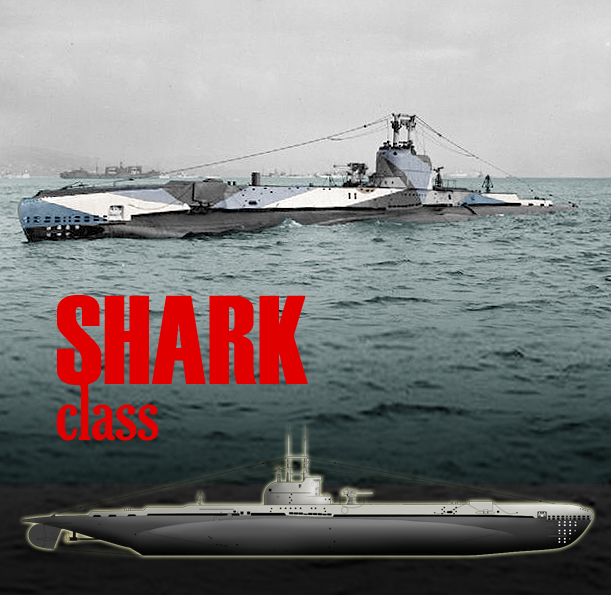
Design of the class
The second group of S-class submarines comprised eight boats in all ordered peace meal but larger than the preceding Swordfish class or retrospectively Group I. They required a larger crew for a similar armament, but performances were increased across the board, notably range, which was important. Construction orders were split between Chatham Dockyard, Scotts (Greenock) and Cammell Laird & Co (Birkenhead) for a construction spread between 1934 and 1937. Thanks to their superior range they were capable of operating from home based down to the Bay of Biscay or Scandinavian coast, one even joining the Soviet Navy, sailing to Murmansk. Fuel oil was indeed raised to 72 long tons and range to 6,000nm (11,100km) at 10 knots (18.5kph) versus 3,700 nmi (6,900 km; 4,300 mi) based on 44 tonnes.
Hull and general design
The Group II were very different in appearance whereas the hull was essentially the same, with identical beam of 24 ft (7.3 m) and same draught at 10 ft 6 in (3.20 m) but the hull was lengthened, from 202 ft 6 in or 61.7 meters to 208 ft 9 in (63.63 m) or 5 feet 3 inches (1,70 m) to accommodate larger fuel tanks in the outer hull. This also benefited the pressure hull, being a bit roomier, albeit they felt just as cramped as before as the crew new required 39 officers and enlisted, three more men than the Group I boats. They were much heavier also, of 30 tonnes standard. When submerged they reached 960 tonnes versus 935 tonnes.


Comparison profiles (by Mike79russia, cc) of both groups, Swordfish ahd Shark classes.
Powerplant
On this chapter they did not diverged much from the previous class, having two shafts propelled when surfaced by each their own Admiralty diesel 1,550 hp total, and when surbmerged, powerful Vickers electric engines rated for 1,440 hp total. HMS Sunfish of the 1934 programme, built at Chatham however had more powerful diesels and its output raised to 1,900 hp surfaced, same 1440 hp when submerged. Fuel oil was initially 39 tonnes (figure given by Conways), but 3800 nautical miles at 10 knots seemed shared by all sources.
The first pair, Sealion and Shark had Diesels rated for 1,550 bhp (1,160 kW) and EM rated for 1,300 hp (970 kW) for a top speed of 13.75 knots (25.47 km/h; 15.82 mph) surfaced and 10 knots (19 km/h; 12 mph) submerged, range of 6,000 nmi (11,000 km; 6,900 mi) at 10 knots surfaced and 64 nmi (119 km; 74 mi) at 2 knots (3.7 km/h; 2.3 mph) submerged.
The second pair was identical. Test depth for all was around 300 feet (91 m).
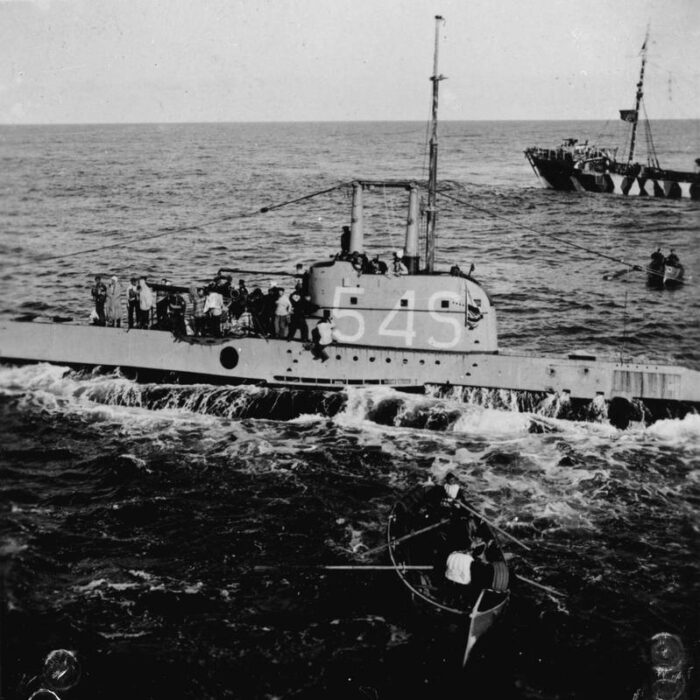
Capture of HMS Shark in June 1940 off Stavanger
Armament
Torpedoes
The 1927 Mark VIII was a real game changer, designed circa 1925, first British burner cycle design torpedo, used from 1927 on all submarines and given to the L class and Odin class, as well as MTBs. In WW2 the Mark VIII** became standard, 3,732 spent by September 1944 (56.4%). It was phased out in the 1990s in Sweden.
⚙ specifications Mark VIII* TORPEDO |
|
| Weight | 3,452 lb (1,566 kg) |
| Dimensions | 259 in (6.6 m) |
| Propulsion | Unknown |
| Range/speed setting | 5,000 yd (4,600 m) at 45.6 kn (84.5 km/h), 7,000 yd (6,400 m) at 41 kn (76 km/h) |
| Warhead | 805 lb (365 kg) Torpex |
3-in/45 20cwt QF Mk II deck gun
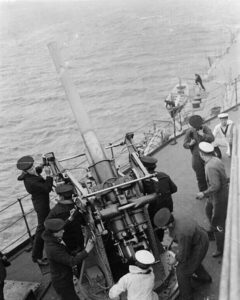 The QF 3-inch 20 cwt anti-aircraft gun became the standard of the Royal Navy in 1914, initially to deal with German Zeppelins airships and bombers, it became ubiquitous on British warships in WWI and submarines in World War II. 20 cwt was for twenty hundredweight (112 lb or 51 kg) with barrel and breech weighting 2,240 lb, 1,020 kg, bore 3 inches (76 mm) and QF for quick firing. Unlike earlier Swordfish class the gun was not placed on a raised platform but directly on deck at the foot of the conning tower. The crew was reduced on the Mark II from 11 to 6.
The QF 3-inch 20 cwt anti-aircraft gun became the standard of the Royal Navy in 1914, initially to deal with German Zeppelins airships and bombers, it became ubiquitous on British warships in WWI and submarines in World War II. 20 cwt was for twenty hundredweight (112 lb or 51 kg) with barrel and breech weighting 2,240 lb, 1,020 kg, bore 3 inches (76 mm) and QF for quick firing. Unlike earlier Swordfish class the gun was not placed on a raised platform but directly on deck at the foot of the conning tower. The crew was reduced on the Mark II from 11 to 6.
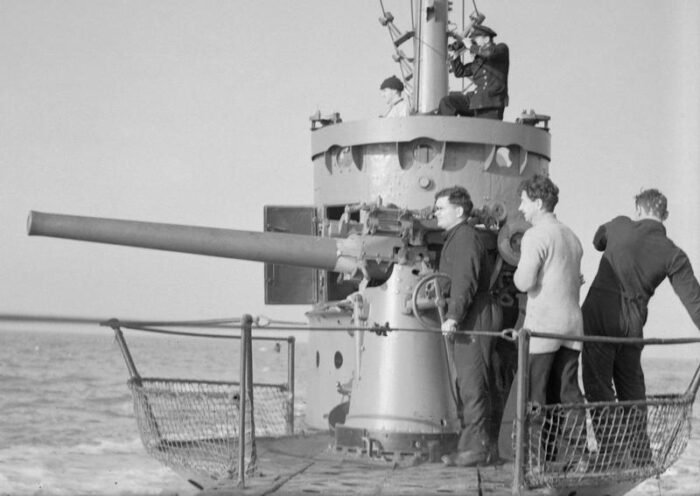
Deck gun in action on HMS Swordfish
⚙ specifications 3-in/45 20cwt Mk II |
|
| Weight | 2,240 lb (1,020 kg), gun and breech |
| Barrel length | Bore: 11 ft 4 in (3.45 m), 11 ft 9 in (3.58 m) |
| Elevation/Traverse | −10 – 90°, 300° |
| Loading system | Semi-automatic sliding-block, hydro spring, constant |
| Muzzle velocity | 2,000 ft/s (610 m/s) |
| Range | 16,000 ft (4,900 m) effective |
| Guidance | Optical, CT telemeter |
| Crew | 6 |
| Round | Fixed QF HE 76.2 × 420 mm R 16 lb (7.3 kg) |
| Rate of Fire | 16–18 rpm |
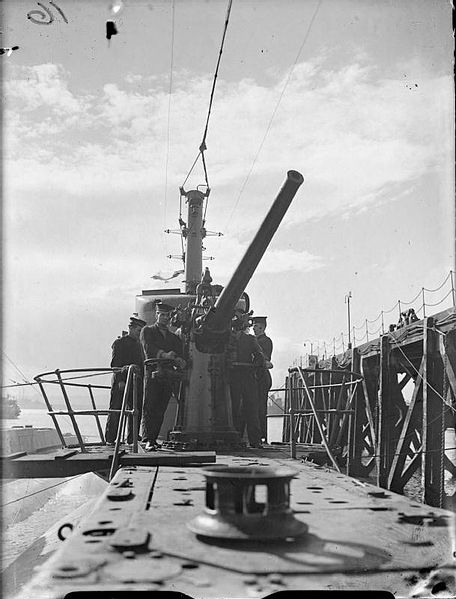
AA: .303/62 Vickers AA
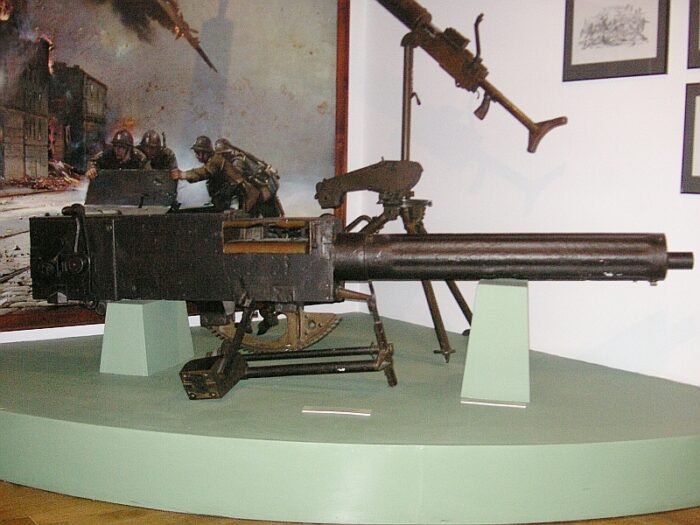
Introduced in 1933, this was essentially a scaled up WWI vickers LMG. Allowing to keep the same rate of fire it quickly became popular as AA gun, at least against low flying 1930s generation aircraft. It was also used on light armoured vehicles and became a widespread AA gun on Royal Navy ships and submarines as well.
Specs:
63 pounds (29 kg) +10 pounds (4.5 kg) cooling water
Length 52.4 in (1.33 m), barrel alone 31 in (0.79 m)
Cartridge 12.7 × 81mm x 0.5 inches (12.7 mm)
Rate of fire: 500–600 rounds per minute, belt fed, 2-3 operators
Muzzle velocity 2,540 feet per second (770 m/s)
Maximum range 4,265 yards (3,900 m), ceiling 9,500 feet (2,900 m)
Sensor: The Type 120 Sonar
February 1932 saw the introduction of the Type 120.106 sonar, an improved Type 118 with almost the same gear and dome but relocated closer to the bow. By 1938 they operated at 10 kHz,107, standard frequency until the end of the 1950s. In WW2 the Type 120 received a 4-ply quartz transducer and better electronics from the Type 123
The Type 120 was fitted on Group I and II of the S Class submarines and Grampus-class. Whe used in the 10 kHz active mode transmitting continuously to get ranges it could be used also to navigate in narrow passages. Upgrades on Seawolf and Sunfish consisted in having the capacity of carrying 12 M2 mines instead of torpedoes. Survivors in 1942-44 received a type 286W or type 291W radar on their conning tower.
⚙ S class Group II specifications |
|
| Displacement | 670 tons surfaced, 960 tons submerged |
| Dimensions | 208 ft 9 in x 24 x 10 ft 6 in (63.63 x 7.3 x 3.20 m) |
| Propulsion | |
| Speed | 13.75 knots (25.47 km/h; 15.82 mph) surfaced, 10 knots (19 km/h) submerged |
| Range | Diesel oil 39t > 72t*: 3800 nm/10 kts |
| Armament | 6× 21-in (533 mm) TTs (12 Mark VIII), 3-in gun QF HA Mk II, 1x .303 HMG AA |
| Sensors | Type 120 sonar |
| Crew | 39 officers and enlisted |
*discrepancy between sources here
Career of the Shark class
 HMS Sealion
HMS Sealion
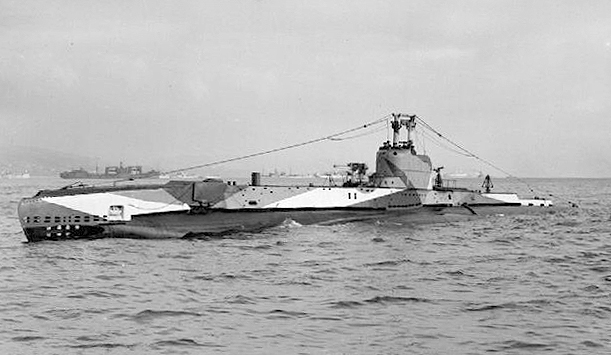
She was ordered under the 1931 construction program, she was laid down on 16 May 1933 in Cammell Laird, launched on 16 March 1934, completed on 21 December. She had an eventful career after 1939 but under command of Lieutenant Commander Benjamin Bryant, she managed to sport and attack the U-21 off the Dogger Bank, in November, but failed to sink her. Next she spotted the German merchant August Leonhardt and torpedoed her in April 1940 off Anholt Island, Dernmak. She later attacked the merchant Moltkefels but missed. She enged with her deck gun the beached Palime, and later spotted and attacked U-62 in July 1940 but missed. She later sank the Norwegian merchant Toran and attacked, missed the Cläre Hugo Stinnes in August 1940..
On 5 February 1941 she shelled and sank the Norwegian cargo-passenger ship Ryfylke. In May she spotted and missed U-74. In July she attacked French shipping, and sank the large fishing vessels Gustav Eugene and Gustav Jeanne, Christus Regnat and St Pierre d’Alcantara.
She was also sent in May to track the German battleship Bismarck.By late 1941 she sank the Norwegian tanker Vesco and Norwegian merchant “Island”. No logs for 1942-45. She ended scuttled as ASDIC target off the Isle of Arran in Firth of Clyde on 13 March 1946.
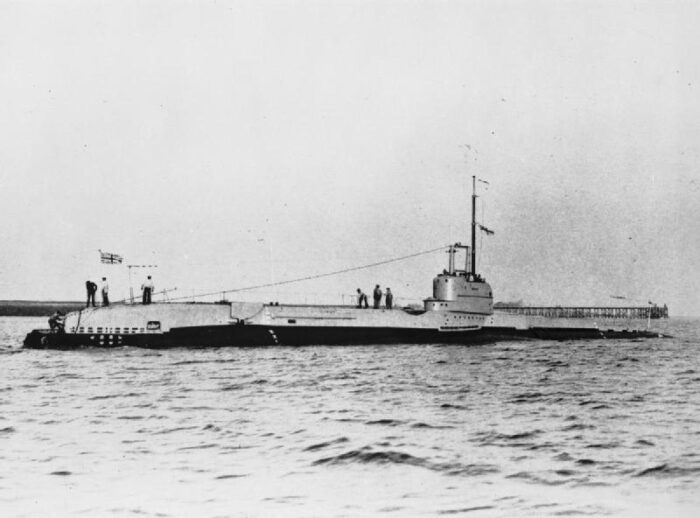
She was ordered under the same 1931 construction program, she was laid down on 15 June 1933 at HM Dockyard, Chatham, launched 31 May 1934, completed 31 December 1934. She was attacked by German aircraft while surfaced on patrol off the coast of Norway off Skudenes, 5 July 1940. She maanged to shoot down a Dornier Do 17 but took herself some damage and was unable to dive. When more Luftaffe aircraft arrived overhead the captain decided to surrender the submarine. The next day at 04:00 German minesweeping trawlers M-1803, M-1806 and M-1807 spotted hher and came close, then at gunpoint transferred the crew as POW, while HMS Shark was taken under tow. Fortunately the crew managed to have her scuttled prior to leaving and cheered when she sunk, forsinc German crews to cut the hawser in order to not be carried with her. She sank stern first 25 nautical miles (46 km) west-south-west of Egersund in Norway.
Captain Lt. Cdr Peter Buckley planned later several escape attempts and W. E. “Wally” Hammond escaped several times before ending in Oflag IV-C – Colditz With ERA Don “Tubby” Lister, both escaped before being transferred to Lamsdorf prison, and escaped from a Breslau work party, managing to reach Switzerland in 1943 and from there get back to Britain.
 HMS Snapper
HMS Snapper
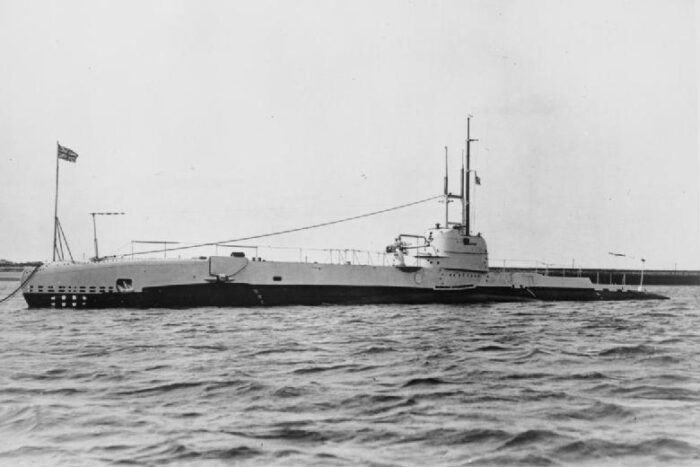
Ordered under the 1932 construction programme, HMS Snapper laid down on 18 September 1933 at HM Dockyard, Chatham, launched on 25 October 1934, completed on 14 June 1935. In 1939 she served in home waters bu was attacked by a British aircraft while off Harwich after a north sea patrol by the RAF, taking a direct hit but without much damage. Her first war patrol victory was the German oil tanker Moonsund, followzs by the merchant Florida, and auxiliary minesweepers M 1701 (H. M. Behrens) and M 1702 (Carsten Janssen) as well as the armed trawler V 1107 (Portland). Later she sank the Norwegian merchant Cygnus. She was spotted and gunned by the armed merchant cruiser Widder, missed.
Her last mission started after leaving her Clyde base on 29 January 1941, for her station in the Bay of Biscay, scheduled to be in the area on 1 February and remain until the 10th, then return with her escort. But she failed to make the rendezvous and for long historians believed she hit a mine or depht charged by a German minesweeper which reported a sub attack on 11 February, notably the German minesweepers M-2, M-13 and M-25. Her wreck has never been found.
 HMS Salmon
HMS Salmon
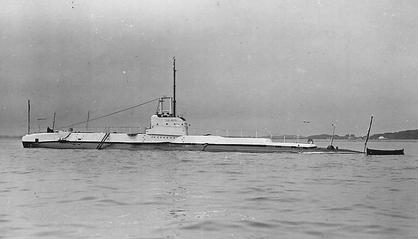
Ordered under the 1932 construction programme, HMS Salmon was laid down on 15 June 1933 at Cammell Laird, Birkenhead, launched on 30 April 1934, completed on 8 March 1935, pennant number 98S.
On 4 December 1939 while on patrol in the North Sea she torpedoed and sank U-36. On 12 December 1939 she sported and prepared to attack the German liner SS Bremen but her escorting Dornier Do 18 forced her to dive. Lt. Cdr. E. O. Bickford could have still torpedo the liner but eventually decided against it, fearing possible retaliation against allied civilian liners. This is believed to have restricted submarine warfare for some time. On 13 December she sighted German warships, fired a spread of torpedoes which hit Leipzig and Nürnberg, and manage to evade destroyers for two hours. Back home she was prepared for more missions but was later lost, presumably hitting a mine on 9 July 1940. In 2008 the survey ship that found HMS Shark’s wreck was remured to have also found the wreck of HMS Salmon nearby off Norway. This remained unconfirmed.
 HMS Seawolf
HMS Seawolf
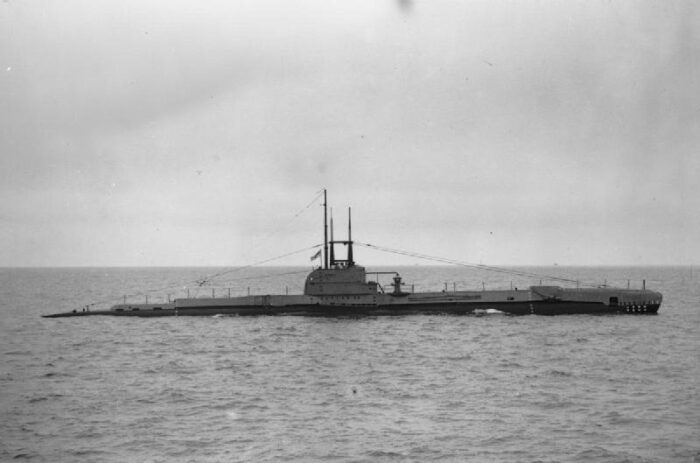
HMS Seawolf was ordered under the 1933 construction programme, laid down on 25 May 1934 in Scotts Shipbuilding & Engineering’s shipyard in Greenock, launched on 28 November 1935, completed on 12 March 1936. She was part of the 2nd Submarine Flotilla and on 23–26 August 1939, she joined the wartime bases at Dundee and Blyth. On 6 October she attacked KMS Nürnberg and escorting TB Falke in the Skagerrak but missed. In April 1940, she sank the German merchant Hamm. In November 1940 she claimed the German merchant Bessheim, but she hit a mine, as reported in German sources, the previous day off Hammerfest. The other merchant is unknown.
She tracked Bismarck in May 1941.
On 6 March 1942, Seawolf she sighted her sister Tirpitz escorted by Z5 Paul Jacobi, Z14 Friedrich Ihn, Z7 Hermann Schoemann and Z25 arriving from Trondheim, to prey on PQ 12. They were too fast for an attack. Her unit was relocated at Halifax, Nova Scotia in 1943, training the RCN for ASW tactics. From August 1943 until 23 August 1944 under Denis Woolnough Mills, she remained there until sold for BU by November 1945 at Marine Industries of Montreal.
 HMS Spearfish
HMS Spearfish
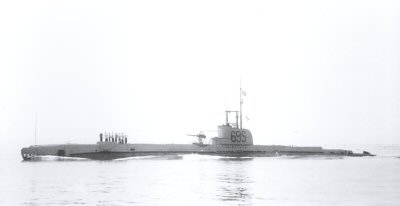
Ordered under the 1934 construction programme, Spearfish was laid down on 23 May 1935 at Cammell Laird, launched on 21 April 1936, completed on 11 December 1936. On 24 September 1939 she was spotted and gunned by German warships off Horns Reef. She escaped while being unable to submerge. A rescue mission from the British Humber force and Home Fleet (notably HMS Ark Royal, HMS Nelson), ordered out of escort duty. They were attacked by Ju 88 bombers from Kampfgeschwader 30, HMS Hood being hit. HMS Spearfish managed to get back to Rosyth on 26 September with repairs completed in early March 1940.
On 11 April 1940 in the Kattegat, under Lt. Cdr John Hay Forbes, she torpedoed KMS Lützow (ex-Deutschland), which stayed inactive in repairs for over a year. This was the best action of the entire class. On 20 May, she sank two Danish fishing vessels (S.130 and S.175) with gunfire. She sailed from Rosyth on 31 July 1940 under “Jock” Forbes to patrol off Norwegian coast and on 1 August was spotted, surfaced, by U-34 (Wilhelm Rollmann) and torpedoed 180 miles (290 km) off Stavanger. Able Seaman William Pester was the only one rescued and became POW.
 HMS Sunfish
HMS Sunfish
Ordered under the 1934 construction programme, she launched on 30 September 1936 and one of 12 boats named in the song “Twelve Little S-Boats”. She was part of the 2nd Submarine Flotilla and in late August she was moved to Dundee and Blyth, under Lt. Cdr J.E. Slaughter. In February 1940, she attacked U-14 but missed. In April she sank the German merchant ships Amasis and Antares, narrowly missed Hanau as well as an auxiliary patrol vessel.
She torpedoed two German ‘Q ships’: Schürbek (Schiff 40) on 12 April (she survived, but was written off), claiming Oldenburg (Schiff 35) on 14 April 1940. On 7 December 1940, she sank the Finnish merchant Oscar Midling, damaged the Norwegian merchant Dixie, both off Norway.
She was then transferred to the Soviet Navy in 1944, renamed V-1 but while underway to murmancks she was bombed and sunk in error by a RAF Coastal Command Liberator off Norway on 27 July 1944. Capt. 2nd rank Fisanovich was allegedly out of his assigned area and about to dive when spotted by the Liberator, but produce recognition signals as instructed, notably by the British liaison staff. Inquiries found that the RAF aircrew was 80 miles off course and ignored the signals. They were later commemorated at the Dundee International Submarine Memorial.
 HMS Sterlet
HMS Sterlet
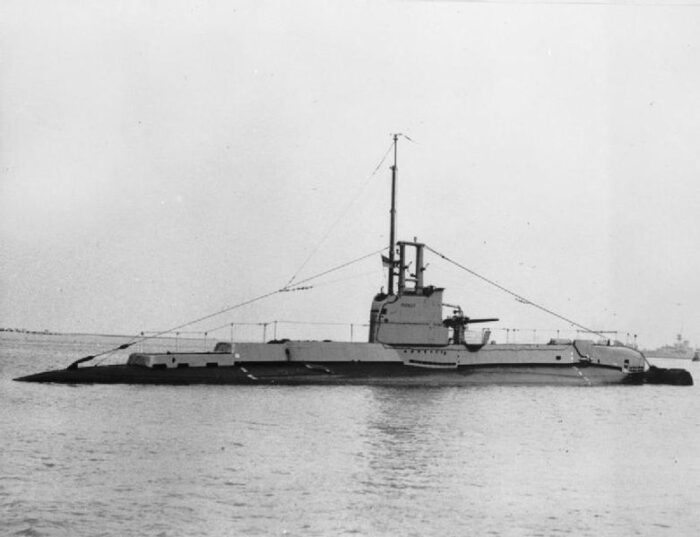
Ordered under the 1935 construction programme, HMS Sterlet was laid down on 14 July 1936 at HM Dockyard, Chatham, launched on 22 September 1936, completed on 6 April 1938 and in the 2nd Submarine Flotilla. She operated from Dundee and Blyth as the war started.
On 8 April 1940 she departed for a patrol in the Skagerrak under Lt. Gerard Henry Stacpoole Haward. On the 12th he spotted a convoy of three merchant ships and a destroyer and attacked but missed. On 14 April HMS Sterlet torpedoed the German gunnery training ship Brummer, which sank the 15th.
Sterlet lmater disappeared in mission, possibly by ASW trawlers UJ-125, UJ-126 and UJ-128 on 18 April, or hit a mine whilst back. Her wreck was not discovered yet.
Read More/Src
Books
Colledge, J. J.; Warlow, Ben (2006) [1969]. Ships of the Royal Navy: The Complete Record. Chatham Publishing.
Bagnasco, Erminio (1977). Submarines of World War Two. Annapolis: Naval Institute Press.
Gardiner, Robert; Chumbley, Stephen (1995). Conway’s All The World’s Fighting Ships 1947–1995. NIP.
van den Pol, E. (1989). “Aspects of submarines – Part I: Some notes on development”. Schip en Werf. Vol. 56.
Links
submarines.dotan.net/
uboat.net
harwichanddovercourt.co.uk
battleships-cruisers.co.uk
ww2-weapons.com/sub-s-class/
rnsubs.co.uk/ sonar.html
en.wikipedia.org/ 21-inch torpedo
navypedia.org/
British subs on naval-encyclopedia.com
en.wikipedia.org/ British S-class submarine 1931
picryl.com/ british s class submarine
Videos
Model Kits
Only found, HMS Rover, Group III

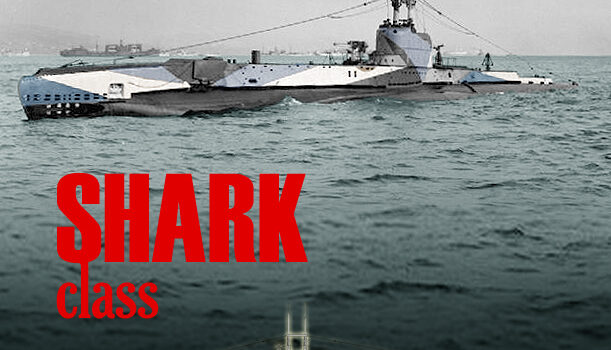
 Latest Facebook Entry -
Latest Facebook Entry -  X(Tweeter) Naval Encyclopedia's deck archive
X(Tweeter) Naval Encyclopedia's deck archive Instagram (@navalencyc)
Instagram (@navalencyc)





 French Navy
French Navy Royal Navy
Royal Navy Russian Navy
Russian Navy Armada Espanola
Armada Espanola Austrian Navy
Austrian Navy K.u.K. Kriegsmarine
K.u.K. Kriegsmarine Dansk Marine
Dansk Marine Nautiko Hellenon
Nautiko Hellenon Koninklije Marine 1870
Koninklije Marine 1870 Marinha do Brasil
Marinha do Brasil Osmanlı Donanması
Osmanlı Donanması Marina Do Peru
Marina Do Peru Marinha do Portugal
Marinha do Portugal Regia Marina 1870
Regia Marina 1870 Nihhon Kaigun 1870
Nihhon Kaigun 1870 Preußische Marine 1870
Preußische Marine 1870 Russkiy Flot 1870
Russkiy Flot 1870 Svenska marinen
Svenska marinen Søværnet
Søværnet Union Navy
Union Navy Confederate Navy
Confederate Navy Armada de Argentina
Armada de Argentina Imperial Chinese Navy
Imperial Chinese Navy Marinha do Portugal
Marinha do Portugal Mexico
Mexico Kaiserliche Marine
Kaiserliche Marine 1898 US Navy
1898 US Navy Sovietskiy Flot
Sovietskiy Flot Royal Canadian Navy
Royal Canadian Navy Royal Australian Navy
Royal Australian Navy RNZN Fleet
RNZN Fleet Chinese Navy 1937
Chinese Navy 1937 Kriegsmarine
Kriegsmarine Chilean Navy
Chilean Navy Danish Navy
Danish Navy Finnish Navy
Finnish Navy Hellenic Navy
Hellenic Navy Polish Navy
Polish Navy Romanian Navy
Romanian Navy Turkish Navy
Turkish Navy Royal Yugoslav Navy
Royal Yugoslav Navy Royal Thai Navy
Royal Thai Navy Minor Navies
Minor Navies Albania
Albania Austria
Austria Belgium
Belgium Columbia
Columbia Costa Rica
Costa Rica Cuba
Cuba Czechoslovakia
Czechoslovakia Dominican Republic
Dominican Republic Haiti
Haiti Hungary
Hungary Honduras
Honduras Estonia
Estonia Iceland
Iceland Eire
Eire Equador
Equador Iran
Iran Iraq
Iraq Latvia
Latvia Liberia
Liberia Lithuania
Lithuania Mandchukuo
Mandchukuo Morocco
Morocco Nicaragua
Nicaragua Persia
Persia San Salvador
San Salvador Sarawak
Sarawak Uruguay
Uruguay Venezuela
Venezuela Zanzibar
Zanzibar Warsaw Pact Navies
Warsaw Pact Navies Bulgaria
Bulgaria Hungary
Hungary

 Bundesmarine
Bundesmarine Dutch Navy
Dutch Navy Hellenic Navy
Hellenic Navy Marina Militare
Marina Militare Yugoslav Navy
Yugoslav Navy Chinese Navy
Chinese Navy Indian Navy
Indian Navy Indonesian Navy
Indonesian Navy JMSDF
JMSDF North Korean Navy
North Korean Navy Pakistani Navy
Pakistani Navy Philippines Navy
Philippines Navy ROKN
ROKN Rep. of Singapore Navy
Rep. of Singapore Navy Taiwanese Navy
Taiwanese Navy IDF Navy
IDF Navy Saudi Navy
Saudi Navy Royal New Zealand Navy
Royal New Zealand Navy Egyptian Navy
Egyptian Navy South African Navy
South African Navy






























 Ukrainian Navy
Ukrainian Navy dbodesign
dbodesign